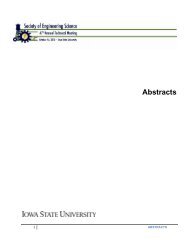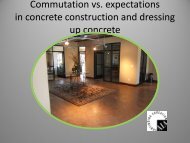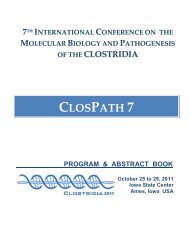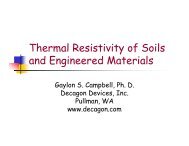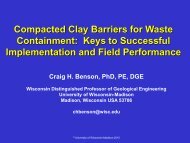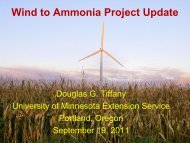Moisture in Concrete Floors, Testing, Analysis and Prevention
Moisture in Concrete Floors, Testing, Analysis and Prevention
Moisture in Concrete Floors, Testing, Analysis and Prevention
Create successful ePaper yourself
Turn your PDF publications into a flip-book with our unique Google optimized e-Paper software.
<strong>Moisture</strong> <strong>in</strong><br />
<strong>Concrete</strong> <strong>Floors</strong>,<br />
Test<strong>in</strong>g, <strong>Analysis</strong><br />
<strong>and</strong> <strong>Prevention</strong><br />
Kev<strong>in</strong> MacDonald, P.E., Ph.D., FACI
Water <strong>in</strong> the Environment<br />
3 phases<br />
Solid<br />
Liquid<br />
Vapour
Psychrometrics
Def<strong>in</strong>ition of Humidity<br />
Relative Humidity RH =<br />
Vapour Pressure<br />
Saturation vapour pressure
1<br />
3 4<br />
2<br />
5<br />
6
Water <strong>and</strong> air <strong>in</strong> equilibrium at<br />
20 o C<br />
Vapour pressure =<br />
2kPa<br />
Saturation vapour<br />
pressure = 2kPa<br />
Relative Humidity<br />
(RH) = 100%<br />
Air at atmospheric pressure<br />
(100 kPa) made up of nitrogen<br />
(approx 70kPa), oxygen <strong>and</strong><br />
other gases <strong>and</strong> water vapour<br />
(approx 2kPa) 100% RH<br />
Water
Half of the gas is replaced with dry<br />
air<br />
Vapour pressure =<br />
1kPa<br />
Saturation vapour<br />
pressure = 2kPa<br />
Relative Humidity<br />
(RH) = 50% (typical<br />
for <strong>in</strong>side a build<strong>in</strong>g)<br />
Air at atmospheric pressure (100<br />
kPa)<br />
water vapour pressure 1kPa<br />
(This will <strong>in</strong>crease to 2kPa with<br />
time)<br />
Water
The temperature is <strong>in</strong>creased rapidly to<br />
near 100 o C (pressure held constant)<br />
Vapour pressure = 1kPa<br />
Saturation vapour pressure<br />
= 90kPa (reaches<br />
atmospheric pressure<br />
at 100 o C)<br />
Relative Humidity (RH)<br />
= 1.1%<br />
To get over 100 o C without<br />
boil<strong>in</strong>g the pressure must be<br />
raised (as for autoclaved<br />
concrete)<br />
Air at atmospheric pressure<br />
(100 kPa)<br />
water vapour pressure 1kPa<br />
(this will <strong>in</strong>crease to 90kPa<br />
with time)<br />
Water
The temperature is decreased below<br />
20 o C (total pressure held constant)<br />
Vapour pressure =<br />
1kPa<br />
Saturation vapour<br />
pressure = 0.5kPa<br />
Relative Humidity<br />
(RH) = 100%<br />
(cannot go above<br />
this. Will cause<br />
condensation or fog)<br />
Air at atmospheric pressure<br />
(100 kPa)<br />
water vapour pressure 1kPa<br />
Water
Relative<br />
Humidity<br />
RH<br />
≈<br />
Massof<br />
Massof<br />
water<br />
water perunitmassof air<br />
perunitmassof airat saturation<br />
Example A shows air at<br />
100% RH <strong>and</strong> 20 o C<br />
heated to 40 o C to give<br />
31% RH<br />
Example B shows air<br />
at 50% RH <strong>and</strong> 20 o C<br />
heated to 40 o C to give<br />
15% RH
Dry-bulb temperature (DBT) is that of an air sample, as determ<strong>in</strong>ed by an ord<strong>in</strong>ary thermometer. It<br />
is typically plotted as the abscissa (horizontal axis) of the graph. The SI units for temperature are<br />
kelv<strong>in</strong>s or degrees Celsius; other units are degrees Fahrenheit <strong>and</strong> degrees Rank<strong>in</strong>e.<br />
Wet-bulb temperature (WBT) is that of an air sample after it has passed through a constantpressure,<br />
ideal, adiabatic saturation process, that is, after the air has passed over a large surface<br />
of liquid water <strong>in</strong> an <strong>in</strong>sulated channel. In practice this is the read<strong>in</strong>g of a thermometer whose<br />
sens<strong>in</strong>g bulb is covered with a wet sock evaporat<strong>in</strong>g <strong>in</strong>to a rapid stream of the sample air (see<br />
Hygrometer). When the air sample is saturated with water, the WBT will read the same as the DBT.<br />
The slope of the l<strong>in</strong>e of constant WBT reflects the heat of vaporization of the water required to<br />
saturate the air of a given relative humidity.<br />
Dew po<strong>in</strong>t temperature (DPT) is the temperature at which a moist air sample at the same pressure<br />
would reach water vapor “saturation.” At this po<strong>in</strong>t further removal of heat would result <strong>in</strong> water<br />
vapor condens<strong>in</strong>g <strong>in</strong>to liquid water fog or, if below freez<strong>in</strong>g po<strong>in</strong>t, solid hoarfrost. The dew po<strong>in</strong>t<br />
temperature is measured easily <strong>and</strong> provides useful <strong>in</strong>formation, but is normally not considered an<br />
<strong>in</strong>dependent property of the air sample as it duplicates <strong>in</strong>formation available via other humidity<br />
properties <strong>and</strong> the saturation curve.<br />
Relative humidity (RH) is the ratio of the mole fraction of water vapor to the mole fraction of<br />
saturated moist air at the same temperature <strong>and</strong> pressure. RH is dimensionless, <strong>and</strong> is usually<br />
expressed as a percentage. L<strong>in</strong>es of constant RH reflect the physics of air <strong>and</strong> water: they are<br />
determ<strong>in</strong>ed via experimental measurement. The concept that air "holds" moisture, or that<br />
moisture “dissolves” <strong>in</strong> dry air <strong>and</strong> saturates the solution at some proportion, is erroneous (albeit<br />
widespread); see relative humidity for further details.<br />
Humidity ratio is the proportion of mass of water vapor per unit mass of dry air at the given<br />
conditions (DBT, WBT, DPT, RH, etc.). Also known as moisture content or mix<strong>in</strong>g ratio. It is<br />
typically plotted as the ord<strong>in</strong>ate (vertical axis) of the graph. For a given DBT there will be a<br />
particular humidity ratio for which the air sample is at 100% relative humidity: the relationship<br />
reflects the physics of water <strong>and</strong> air <strong>and</strong> must be determ<strong>in</strong>ed by measurement. The dimensionless<br />
humidity ratio is typically expressed as grams of water per kilogram of dry air, or gra<strong>in</strong>s of water<br />
per pound of air (7000 gra<strong>in</strong>s equal 1 pound
Ideal Solution Behaviour<br />
Dalton’s Law<br />
• The pressure of each constituent is proportional<br />
to the mole fraction <strong>and</strong> the total pressure<br />
Raoult’s Law<br />
• The pressure above a solution is proportional to<br />
the mole fraction of the component <strong>in</strong> the<br />
solution
Colligative Properties of<br />
Nonelectrolyte Solutions<br />
Vapor-Pressure Lower<strong>in</strong>g; The vapor pressure of a<br />
Solution is lower than pure solute.<br />
P 1 0 = vapor pressure of pure solvent<br />
Raoult’s law<br />
X 1 = mole fraction of the solvent<br />
P 1 = X 1 P 0 1<br />
Mole Fraction (X 1 )<br />
moles of 1<br />
sum of moles of all components
If the solution conta<strong>in</strong>s only one solute:<br />
X 1 + X 2 =1<br />
X 1 = 1 – X 2<br />
X 2 = mole fraction of the solute<br />
X 1 = mole fraction of the solvent<br />
P 1 = X 1 P 1 0<br />
P 1 = (1-X 2 ) P 1 0<br />
P 1 = P 0 1-P 0 1X 2<br />
P 1 0 - P 1 = ∆P = X 2 P 1 0
The presence of a non-volatile solute means that<br />
fewer solvent particles are at the solution’s<br />
surface, so less solvent evaporates!
Describe what is happen<strong>in</strong>g <strong>in</strong> the pictures below.<br />
Use the concept of vapor pressure lower<strong>in</strong>g to<br />
expla<strong>in</strong> this phenomenon.
Impacts on Project & Owner<br />
Vapor Emission<br />
Delayed floor<strong>in</strong>g <strong>in</strong>stallations<br />
• Delayed project completion<br />
• Time<br />
Mold / mildew <strong>and</strong> alkali damage<br />
Short/long-term adhesive bond<strong>in</strong>g<br />
• Repair Costs<br />
Voided Warranties<br />
Downstream Client Costs<br />
• LOST PROPERTY USE<br />
• LOST WORKER PRODUCTIVITY<br />
• LOST OWNER INCOME<br />
Its estimated that vapor emission related floor<strong>in</strong>g failures<br />
cost <strong>in</strong>dustry <strong>in</strong> the U.S. billions of dollars annually <strong>in</strong><br />
damage, downtime, repair <strong>and</strong> replacement.<br />
21
Epoxy system <strong>in</strong> Airport Hanger<br />
V<strong>in</strong>yl Tile <strong>in</strong> Retail Store<br />
Rubberized Floor <strong>in</strong> Health Center
Mold/mildew<br />
Mold flourishes <strong>in</strong> moist environments <strong>and</strong><br />
organic compounds found <strong>in</strong> construction<br />
materials<br />
Sick build<strong>in</strong>g syndrome<br />
- Chemical/Biological contam<strong>in</strong>ation<br />
- Toxic mold
Related ASTM Procedures<br />
<br />
<br />
<br />
<br />
<br />
<br />
<br />
<br />
<br />
<br />
C 109/C 109M Test Method for Compressive Strength of Hydraulic Cement<br />
Mortars<br />
C 309 Specification for Liquid Membrane-Form<strong>in</strong>g Compounds for Cur<strong>in</strong>g<br />
<strong>Concrete</strong><br />
C 472 Test Method for Compressive Strength of Gypsum Cement<br />
D 4259 Practice for Abrad<strong>in</strong>g <strong>Concrete</strong><br />
E 1155 Test Method for Determ<strong>in</strong><strong>in</strong>g FF/FL (Floor Flatness <strong>and</strong> Floor<br />
Levelness)<br />
E 1486 Test Method for Determ<strong>in</strong><strong>in</strong>g Floor Tolerances Us<strong>in</strong>g Wav<strong>in</strong>ess,<br />
Wheel Path, <strong>and</strong> Levelness Criteria<br />
E 1745 Specification for Plastic Water Vapor Retarders Used In Contact<br />
With Soil or Granular Fill Under <strong>Concrete</strong> Slabs<br />
F 141 Term<strong>in</strong>ology Relat<strong>in</strong>g to Resilient Floor Cover<strong>in</strong>gs<br />
F 1869 Test Method for Measur<strong>in</strong>g <strong>Moisture</strong> Vapor Emission Rate of<br />
<strong>Concrete</strong> Subfloor Us<strong>in</strong>g Anhydrous Calcium Chloride<br />
F 2170 Test Method for Determ<strong>in</strong><strong>in</strong>g Relative Humidity <strong>in</strong> <strong>Concrete</strong><br />
Floor Slabs Us<strong>in</strong>g In Situ Probes
Porosity<br />
The porosity (p) is def<strong>in</strong>ed as:<br />
p = volume of pores × 100 %<br />
Bulk volume<br />
The bulk volume is measured by measur<strong>in</strong>g the<br />
dimensions of the solid <strong>and</strong> multiply<strong>in</strong>g height<br />
× width × depth.
Modified Pore Structure<br />
Gel pores<br />
Capillary Pores<br />
OPC<br />
60 %<br />
Hydration<br />
Intruded Volume<br />
OPC +<br />
GGBFS<br />
0.001 0.01 0.1 1<br />
10<br />
Pore diameter, μm
Dry<strong>in</strong>g of materials<br />
The rate of evaporation will depend on<br />
temperature, the relative humidity near<br />
the surface, the chemistry of the pore<br />
solution, <strong>and</strong> the exposed surface area.<br />
The relative humidity near the surface<br />
will be controlled by air movement (w<strong>in</strong>d<br />
or convection).<br />
Materials with salt <strong>in</strong> the pores will tend<br />
to attract moisture <strong>and</strong> are described as<br />
"hygroscopic".<br />
The exposed surface area will be the<br />
porosity × the area.
Condensation <strong>in</strong> pores<br />
The conditions under which water will susta<strong>in</strong> a<br />
meniscus <strong>in</strong> small pores are given by:<br />
r Ln(RH) = - 2 m s<br />
ρ R T<br />
where: r is the pore radius <strong>in</strong> m<br />
Ln(RH) is the natural log of the relative humidity<br />
m is the molecular weight of water = 0.018 kg/mol<br />
s is the surface tension of water = 0.073 N/m<br />
ρ is the density of water = 1000 kg/m 3<br />
R is the gas constant = 8.3 J/mol/ o K<br />
T is the temperature = 290 o K (at 20 o C)
Water <strong>in</strong> <strong>Concrete</strong><br />
A pore of radius 3 × 10 -9 m will fill with water<br />
at humidities over 70%. Thus <strong>in</strong> a moist<br />
atmosphere concrete will absorb a large<br />
amount of water.
Dry<strong>in</strong>g of <strong>Concrete</strong><br />
Water to Cement<br />
ration (w/c) is the<br />
ma<strong>in</strong> driver for<br />
concrete dry<strong>in</strong>g
Water Cement Ratio<br />
Low<br />
High
ASTM F 710 – Industry St<strong>and</strong>ard<br />
• Establishes recommendations of MVER (ASTM F 1869)<br />
• Establishes <strong>in</strong>ternal relative humidity test<strong>in</strong>g recommendations<br />
(ASTM F 2170)<br />
• Establishes procedures for prepar<strong>in</strong>g floors<br />
• Establishes pH test<br />
Hardened cement paste reacts with atmospheric CO 2 which reduces the pH of<br />
the surface to approximately 8.5
Us<strong>in</strong>g ASTM F 710….<br />
Quantitative Test<br />
ASTM F 1869<br />
• Calcium Chloride (MVER)<br />
ASTM F 2170<br />
• Internal Relative Humidity
<strong>Moisture</strong> Vapor Emission Rate<br />
Measures moisture absorbed by<br />
CaCl 2<br />
Most accurate <strong>in</strong> a build<strong>in</strong>g<br />
environment under “expected<br />
normal use” conditions<br />
Target F 710 recommendations<br />
Some floor<strong>in</strong>g <strong>in</strong>stallers won’t<br />
use this test
Advantages<br />
It is Quantitative<br />
Determ<strong>in</strong>es moisture be<strong>in</strong>g<br />
emitted at one area of the<br />
surface<br />
Relatively easy test to perform<br />
Gives a quantitative results<br />
Disadvantages<br />
Not totally accurate MVER<br />
Chloride draws water out of surface<br />
(can be mislead<strong>in</strong>g)<br />
Only measures the top surface of the<br />
concrete<br />
Affected by ambient temp <strong>and</strong> dew<br />
po<strong>in</strong>t conditions
MVER Test<br />
Test Run at 73F <strong>and</strong> 50% RH
MVER Test<br />
Test Run at 73F <strong>and</strong> 50% RH
ASTM F 2170<br />
• Measurement for the <strong>in</strong>ternal<br />
relative humidity of concrete<br />
• Taken at 40 % of the slab<br />
depth if one-way dry<strong>in</strong>g<br />
• Target from F 710<br />
recommendations
ASTM F 2170<br />
Advantages<br />
Disadvantages<br />
Quantitative<br />
BEST predictor of “true”<br />
moisture with<strong>in</strong> a slab<br />
Relatively easy to run<br />
Considers moisture gradient <strong>in</strong><br />
a slab<br />
Measures moisture expected to<br />
equalize at the surface of<br />
concrete<br />
Accuracy of probes can be a<br />
question<br />
Leapfrogg<strong>in</strong>g probes could give<br />
bad results<br />
Requires recalibration
Relative Humidity Test<br />
Test Run at 73F <strong>and</strong> 50% RH
Relative Humidity Test
Conventional Floor Slab, w/c = 0.50<br />
≈ 150 pounds/yard of water of convenience<br />
If a <strong>in</strong>ternal relative humidity is not tested,<br />
future moisture related problems are likely from:<br />
1. <strong>Moisture</strong> Vapor Migration<br />
2. pH > – Controlled with rapid-dry<strong>in</strong>g concrete
General Guidel<strong>in</strong>es of ASTM F-710<br />
Dry, clean, smooth <strong>and</strong> structurally sound…<br />
Surface cracks <strong>and</strong> control jo<strong>in</strong>ts should be<br />
filled…<strong>and</strong> provide a m<strong>in</strong>imum of 3000 psi<br />
compressive strength <strong>in</strong> 28 days<br />
Expansion jo<strong>in</strong>ts shall not be filled…<br />
Surface must be cleaned…<br />
No asphaltic adhesive residues…<br />
Shall be smooth <strong>and</strong> flat…with<strong>in</strong> 3/16” <strong>in</strong><br />
10ft.
Test<strong>in</strong>g a Slab per ASTM F-710<br />
Removal of sealers, cur<strong>in</strong>g agents, bond<br />
breakers otherwise known as the “water drop<br />
test”<br />
<strong>Moisture</strong> Test<strong>in</strong>g<br />
• <strong>Moisture</strong> Vapor Emissions Rate (MVER)<br />
• In Situ RH (Relative Humidity)<br />
pH Test<strong>in</strong>g
<strong>Concrete</strong> <strong>Moisture</strong> Basics<br />
Underst<strong>and</strong><strong>in</strong>g how water moves through<br />
hardened concrete is important <strong>in</strong><br />
determ<strong>in</strong><strong>in</strong>g:<br />
• Consequences of the moisture movement;<br />
• Effectiveness of moisture test<strong>in</strong>g methods; <strong>and</strong><br />
• Validity of floor<strong>in</strong>g manufacturers’ warranty<br />
recommendations
<strong>Moisture</strong> Sources<br />
Water of Hydration<br />
• Water required to complete chemical reaction<br />
<br />
Typically considered ~25% of cement by weight<br />
Water of Convenience<br />
• Water used for ease of workability <strong>and</strong><br />
placement<br />
<br />
Usually another 25% to 40% of cement by weight<br />
<strong>Moisture</strong> Vapor Transmission (MVT)<br />
• Water of convenience evaporat<strong>in</strong>g<br />
<br />
4” slab poured at .50 W/C evaporates >½ gallon per sq ft.<br />
• Water com<strong>in</strong>g up through the concrete from<br />
under slab
Wett<strong>in</strong>g Dry<strong>in</strong>g Hysteresis<br />
<strong>Moisture</strong> Content<br />
Wett<strong>in</strong>g<br />
Dry<strong>in</strong>gg<br />
Time
Effects of Secondary <strong>Moisture</strong><br />
Exposure<br />
<strong>Concrete</strong> slabs,<br />
properly prepared<br />
<strong>and</strong> under functional<br />
HVAC control typically<br />
take 50-90 days to<br />
reach moisture levels<br />
suitable for “normal”<br />
floor cover<strong>in</strong>g<br />
<strong>in</strong>stallation<br />
• Rewett<strong>in</strong>g resets<br />
the dry time clock<br />
my several weeks
Reported by ACI Committee 302 -2006<br />
Guide for <strong>Concrete</strong> Slabs that<br />
Receive <strong>Moisture</strong>-Sensitive<br />
Floor<strong>in</strong>g Materials
<strong>Concrete</strong> Cur<strong>in</strong>g/Dry<strong>in</strong>g<br />
After cur<strong>in</strong>g <strong>and</strong> before dry<strong>in</strong>g<br />
beg<strong>in</strong>s, the moisture distribution<br />
<strong>in</strong> a hardened concrete slab is<br />
reasonably uniform throughout<br />
the member thickness (Hanson<br />
1968). As concrete dries, the<br />
amount <strong>and</strong> distribution of<br />
moisture changes (Hedenblad<br />
1997).
Surface Shr<strong>in</strong>kage (Curl)<br />
Gr<strong>in</strong>d it to make it flat<br />
Only to have it <strong>in</strong>vert after cover<strong>in</strong>g
Cur<strong>in</strong>g/Dry<strong>in</strong>g of Lightweight &<br />
Normal <strong>Concrete</strong>
<strong>Moisture</strong> Movement
<strong>Moisture</strong> Movement<br />
Both phases<br />
Capillary Rise<br />
Diffusion<br />
Absorption / Desorption<br />
Flow
Water Movement - Diffusion<br />
J = −D ∂∂<br />
∂∂
What can we do?
It depends when<br />
Before Construction<br />
• Install a Vapour Barrier<br />
• Elim<strong>in</strong>ate vapour sensitive cover<strong>in</strong>gs<br />
• Use a low permeability <strong>Concrete</strong><br />
• Use a self –desiccat<strong>in</strong>g concrete<br />
After Construction<br />
• Wait<br />
• Apply a topical protection
T, H<br />
T, H
T, H<br />
T, H
T, H<br />
T, H
T, H<br />
T, H
Deep Slab Relative Humidity
It Also Dries throughout the Depth<br />
Conventional <strong>Concrete</strong><br />
Dry<strong>in</strong>g to this depth could take<br />
years<br />
Rapid-Dry<strong>in</strong>g <strong>Concrete</strong><br />
Dry<strong>in</strong>g throughout the depth will<br />
take roughly 30 days
Questions?<br />
Thanks for the time <strong>and</strong> attention



